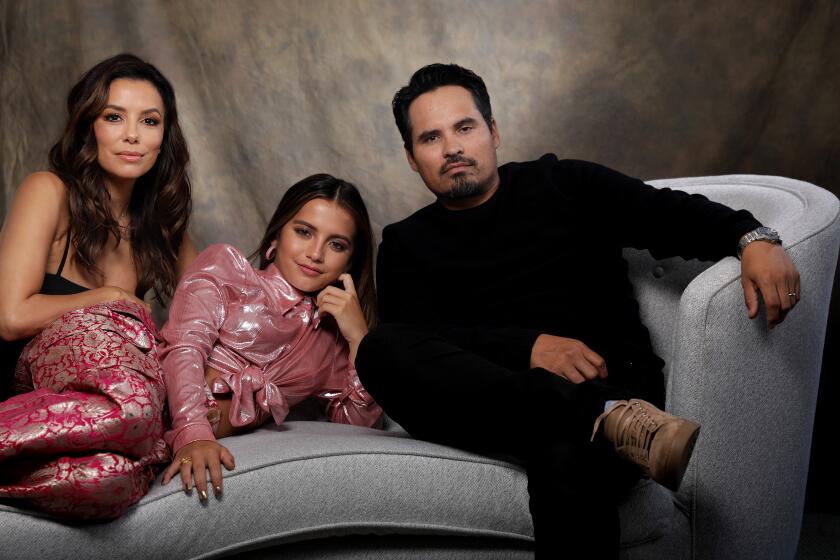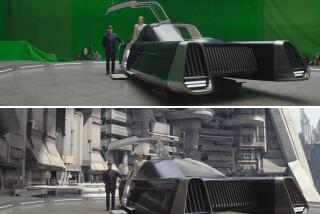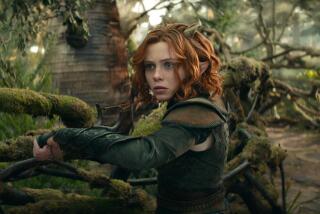How the live-action ‘Dora’ movie stays true to its animated roots
- Share via
When teenage Dora first appears in “Dora and the Lost City of Gold,” she directly addresses viewers with her signature greeting: “Hi, I’m Dora!”
It’s clear from that moment that this live-action Dora, played by actress Isabela Moner, is the same super cool exploradora that children all over the world have watched since the animated “Dora the Explorer” debuted in August 2000. She’s just grown up a little.
For director James Bobin, that spark of recognition was integral for “Dora and the Lost City of Gold.”
“Dora is relentlessly positive in a very sweet way,” Bobin told The Times. “You want to stay true to the character. The most important thing is the character has to be recognized.”
Live-action adaptations of popular cartoons are nothing new in Hollywood, but “Dora” is unique because its source is a bilingual educational program for preschoolers.
In Paramount’s live-action “Dora the Explorer” film, five lead actors are of Latino descent. Director James Bobin and stars Isabela Moner, Eva Longoria, Michael Peña and Eugenio Derbez discuss the character’s big-screen debut with “Dora and the Lost City of Gold.”
Since its debut, “Dora the Explorer” has been seen all over the world. Airing in over 100 other countries and dubbed in 30 different languages, the animated Dora is world famous.
Created by Chris Gifford, Valerie Walsh Valdes and Eric Weiner, the original series sees Dora routinely break the fourth wall to encourage interaction from her young viewers (early seasons of the show even included little features to make it seem as if Dora was the main character of a computer game). Repetition, songs and solving puzzles are all built into the show’s DNA to help kids learn in both Spanish and English.
Most of Dora’s cohorts in her Nickelodeon series are cute, talking animals. And she is also never without her singing backpack and map. It’s difficult to imagine all of these essential elements of the show being translated into a live-action movie, but “Dora and the Lost City of Gold” makes it work.
“I wanted to respect the source material because without the material we wouldn’t be here,” said Bobin.
That means this Dora is just as positive and encouraging as her animated counterpart, but just a little more aware because she is a teenager. She still sings, is eager to learn and effortlessly switches between languages. She even carries a backpack loaded up with all the things and knick-knacks she might need.
But Bobin was mindful about stuffing the movie full of endless Easter eggs just because.
“I wanted to put stuff in the movie where you kind of go, ‘Oh, I remember that,’ ” said Bobin. But “I didn’t want to squeeze stuff in just for no reason. I thought things needed to earn their place. That’s kind of how we did it.”
Some of these nods come in the opening moments of the film while Dora and her cousin Diego (who in addition to appearing in the original show was the star of his own spinoff series, “Go, Diego, Go!”) are playing in the jungle as young children. This includes Dora breaking the fourth wall to ask people watching if they can say delicioso, to the confusion of her parents (played by Eva Longoria and Michael Peña).
The movie also features CGI Boots and Swiper, two characters that regularly appear in “Dora the Explorer.” Boots, of course, is Dora’s monkey friend who in the animated series wears actual boots. Swiper is the sneaky fox that’s usually causing trouble by trying to steal stuff from Dora and her friends. Yes, both animals talk in the cartoon.
Bobin says that adapting Boots and Swiper for this film was difficult because of the need to balance the photorealism of the characters with their cartoony antics. And they decided early on to lean into more of the cartoon elements for both of the characters.
“Boots is not any kind of monkey you see in the real world,” said Bobin. “His facial characteristics are still that of the character from the cartoon because I knew he was going to do stuff that would be much funnier that way.”
The same approach was taken with Swiper, because a talking fox that wears gloves can only look so real.
The most direct homage to “Dora the Explorer,” however, comes in the form of an actual animated sequence later in the film.
“[The scene] pays tribute to where we’re from, but also is our updated version of it,” said Bobin.
After Dora, Diego and Alejandro are exposed to some hallucinogenic spores, their entire reality transforms into a cartoon. Bobin described the scene as “a fun little moment” that “also felt very earned and like an essential part of the narrative.” And it’s during this sequence that viewers can spot other familiar faces from the original show.
“I felt that it would be fun to see Isabela, as an older Dora, what she would look like as a cartoon character,” said Bobin. “And I think that also allows you to show characters from the cartoon which you wouldn’t be able to show otherwise within the movie without making things super forced.”
“When you’re making a movie of a TV show, the movie would not exist without that TV show so I was really keen to say thank you to those guys,” said Bobin.
It’s this thoughtful reverence of the original show while being committed to telling its own adventure story that makes “Dora and the Lost City of Gold” a pleasant surprise. But don’t fret if you’re not a “Dora the Explorer” fan, this live-action adaptation of an educational cartoon for youngsters can appeal to everyone.
Times staff writer Sonaiya Kelley contributed to this story.
More to Read
Only good movies
Get the Indie Focus newsletter, Mark Olsen's weekly guide to the world of cinema.
You may occasionally receive promotional content from the Los Angeles Times.












